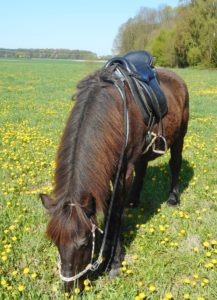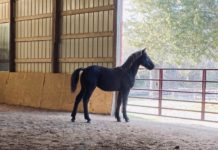
Frankfurt, Germany (Weltexpress). Those writers who wish to distinguish themselves as horse ‘insiders’ often claim that their article is “scientific” or refer to their “scientific findings”. On close inspection, however, this is often no more than pseudoscience or, at best, subjective information based on personal or freign experience. Again, to lend a scientific air, such articles may be illustrated with anatomical diagrams of the skeleton, muscles, and ligaments; an approach that often betrays mechanistic thinking and the fallacious goal:
The horse has to work!
Scientific research, however, aims for objective information on nature and behavior. It looks at the horse in all its facets, seeks out root causes and makes use of exacting methods of investigation. Such an approach is exemplified by data on 66 “natural experiments” compiled by Prof. W. R. Cook of Tufts University in Massachusetts and statistically analysed by M. Kibler.
Sixty-six owners who had elected to switch their horse from bit to bitless, documented their horse’s behavior before and after the switch, using a questionnaire listing 69 ‘unwanted’ behaviors. The questionnaire was based on 6 years of feedback from riders who had already switched from a bit to a bitless bridle and had reported on the improvements in behavior their horse had exhibited.
The 69 behaviors included all-too-familiar problems such as ‘difficult to bridle’, ‘grabbing the bit’, ‘headshaking’ and ‘tongue over the bit’. (See link to the full text below and Table 1). Horse age ranged from 3 to 24 years and the study population included many different breeds and disciplines. When bitted a variety of bits were used and when bit-free all were ridden in a crossunder bitless bridle.
When bitted, the mean number of ‘unwanted’ negative behaviors (i.e., pain indices) per horse was 23 (range 5-51). After being free of the bit for a mean period of 35 days, the mean was 2 (range 0-16).
Only one horse, after 30 days without a bit, showed no improvement in behavior . The total number of pain indices in the population when bitted was 1575 and when bitless 208; an 87% reduction in pain and improvement in behavior.
Since it is now well established that any horse can be ridden with or without a bit, even at the highest sporting level, it is an anachronism that riding federations pose as animal welfare guardians for the horse yet at the same time mandate use of a bit.
The investigation recognized that horses experience both negative and positive emotions. Accordingly, the results when bitted and bitless were assessed on both aspects; welfare compromise (pain) and welfare enhancement (pleasure). In sum, when bitted the population exhibited marked to severe pain and no pleasure and when bitless, low pain and mid-level pleasure. It was reasonable to assume that with continued use of a bitless bridle, the pleasure/pain equation would continue to favor the pleasure side of the equation.
In false expectation of increased safety, riders tend to emphasize the importance of a horse showing obedience to the aids. Unfortunately, this has led to the idea that the stronger the force the better, hence more severe bits come to be regarded as ‘safer’. But this research shows quite the opposite. ‘Loss of control’ was common when bitted but not a problem when bitless. The horses more readily accept reins aids when they are done without pain.

The bit was by far the most common cause of pain in the population when bitted. As bit-induced pain is manifested largely by behavioral changes expressed through aberrant movement of the head spine and limbs, i.e., abnormalities of gait, the ‘unwanted’ behaviors were collectively described as varying forms of ‘bit lameness’.
All of the behaviors except one (‘excess salivation‘) met a definition of stereotypical behaviour, i.e., ‘repetitive behaviours induced by frustration, repeated attempts to cope, and/or CNS dysfunction’. Their reversibility indicated that ‘CNS dysfunction’ was not their cause but ‘frustration’ and ‘attempts to cope’ were descriptions that fitted like a glove. A horse’s aversion to the bit was explained on the grounds of a fundamental principle of living organisms called stereotaxis. This is ‘the positive (or negative) response of a freely moving organism to cling to (or avoid) a solid object’. As the authors wrote, „Indisputably, a bit is a ‘solid’ object“. A horse is innately evolved, they explain, to (try and) move away from (evade) the bit; to exhibit negative stereotaxis. From this it followed that the oft-cited dressage injunction – a horse should ‘accept the bit’ is an unrealistic expectation. Cook and Kibler concluded that horses are born being biologically averse to the bit.
The study was published on March 31, 2018 in the Journal of Equine Veterinary Education, the full text is freely available. Robert Cook and Matthew Kibler: Behavioural assessment of pain in 66 horses, with and without a bit



















